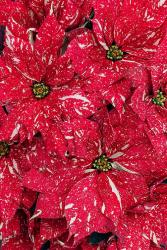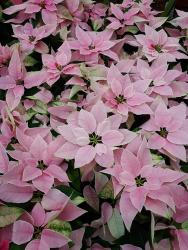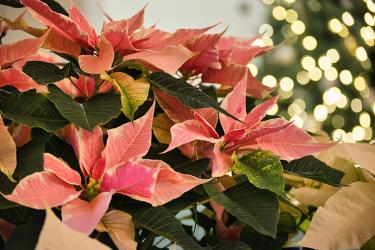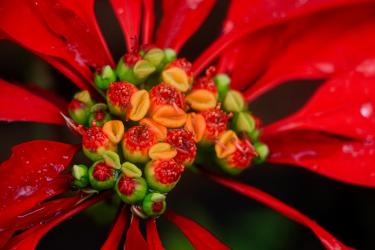More about the Bracts: The brilliant poinsettia flowers that we know and love aren’t actually flowers! They’re made up of colorful bracts, or leaves, that change color in response to shorter winter days. Poinsettias do have small yellow flowers in the center called cyathia, but the bright bract hues are what actually attract pollinators.
A Bad Rap: Contrary to popular belief, poinsettias are not actually harmful to human or animal health unless ingested in large quantities; that being said, they really shouldn’t be eaten. To play it safe, keep out of immediate reach of children or pets.
More prevalent are mild reactions to the white sap, which can cause a skin rash. Gloves are recommended when working with plants. If sap does get on your hands, wash off immediately and avoid contact with your eyes and mouth.
General Maintenance: Though poinsettias do prefer the shorter days after the fall equinox, that doesn’t mean to keep them out of the light. Make sure to place them in a eastern or western facing window for bright daylight. It’s ideal to keep them between 65 and 75 degrees fahrenheit, but they won’t be damaged unless they are exposed to temperatures less than 50 degrees.
It’s important to keep the soil moist without drowning the poinsettia. First, remove the decorative foil before watering, as this could hold in moisture and expedite root rot. If the soil surface feels dry to the touch or the pot feels light, set it in a sink and water thoroughly until completely drained.
Steps to Rebloom: It really can be done! Excluding the poinsettia from light for a certain period of time while keeping the plant healthy keeps it from producing chlorophyll, which will make it green.
New Year’s Day: If you begin to see new growth on or after New Year’s Day, fertilize the plant at half strength. Adequate light and water will extend holiday color and blooms. If your plant is still going strong by Valentine’s Day, consider cutting back “leggy” bits to make it grow more compactly.
Spring: When St. Patrick’s Day rolls around, prune off any faded or dead leaves and stalks, making sure to keep the soil surface free of debris. On or after Memorial Day, trim off several inches of the plant to promote side branching. If you plan on growing the poinsettia as a potted plant, move into a larger pot 2-3 inches larger than the first.
Summer: You can move the plant outside for the summer and place it in indirect sunlight. If you’d like, you can even plant it directly into your garden. By the Fourth of July, the poinsettia can be moved into full sun and the fertilizer increased to help accelerate growth.
Labor Day: If nights start reaching less than 65 degrees, move the plant back inside with a properly sized pot to accommodate its summer growth. As new growth begins, reduce the amount of fertilizer to one fourth of the recommended amount.
Autumn: Now the real work begins! Around September 21, place the plant in a closet, basement or box for 16 hours of uninterrupted darkness, and bring it out for 8 hours of sunlight a day. Maintain night temperature to as close to 60 degrees as possible, and in daylight hours make sure to turn the plant daily so it receives even amounts of light on all sides.
By Thanksgiving, you can discontinue the day/long night treatment and opt for a location that provides at least six hours of direct sunlight. Reduce water and fertilizer as it won’t require it during the holiday season.
Winter: Welcome in the holiday spirit with your “new” poinsettia!













